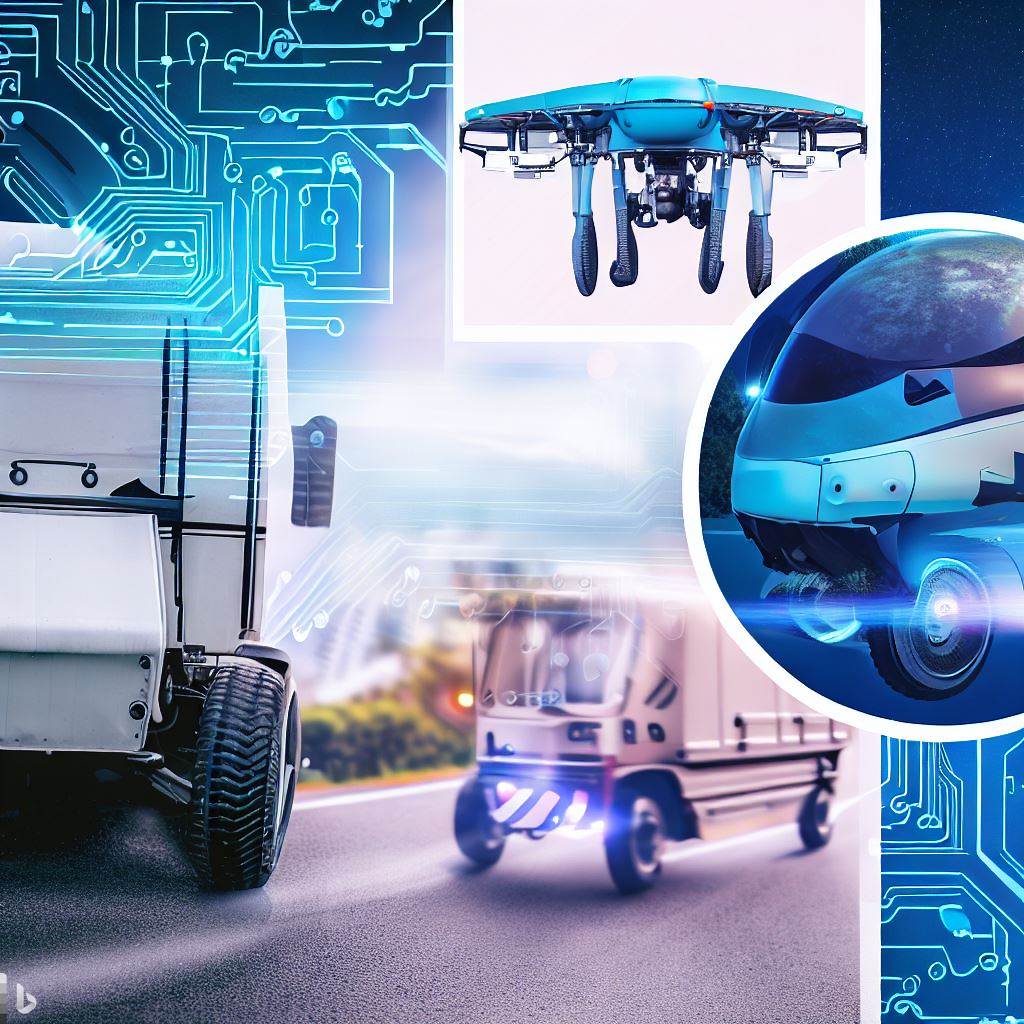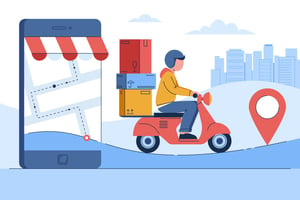The growth of e-retailing has been instrumental in expanding the scope of last-mile delivery...
The Future of Deliveries: Innovations in Delivery Management
Deliveries have advanced at an unprecedented pace. Expectations on speed are more than ever before in the history of deliveries. Here-and-now will soon be the new normal and this would be possible only if managing deliveries embrace innovation.

As sweeping changes happen, businesses are pivoting faster toward the future. The ones that fail would perish. As these changes are taking place, here is a look at some innovations and trends that are most likely to influence the future of deliveries.
Innovations in Delivery Management Software

- Artificial Intelligence in Routing
- Robotics in deliveries
- Green Fleet
- Drone Deliveries
Artificial Intelligence In Routing
Route optimization in delivery management software enables logistic businesses to create optimal route plans. With the innovation of AI, the routing feature can be further enhanced to optimize routing decisions based on predictive analysis, GIS, and historical data. Machine learning ( ML) is a part of AI that helps systems get incrementally better with pattern identification and data analysis. This will impact routing accuracy, speed and allocation of resources to pave way for faster deliveries.
Businesses can leverage ML to optimize routing decisions, predict demands of orders and supplies, automate order cycles, forecast on-ground disruptions, and uncover customer demand patterns. Another operational impact AI can have in businesses especially retail is that it opens new doors for cross-selling and upselling through its chatbots. AI helps segment customers based on their buying behavior, spending capacity, and need for particular features. AI-powered chatbots sharpen the pitching efforts through this predictive analysis. Businesses can leverage the benefit to expand their revenue streams as upsells contribute 70% to 95% of total revenue.
Moreover, businesses that have started early adoption of AI implementation have reduced their logistics costs by 15% and have gained 30% in delivery efficiency.
AI in routing algorithms can empower the delivery operations by offering different sets of data such as;
- Descriptive Data: To evaluate your fleet performance
- Diagnostic Data: To identify and analyze bottlenecks of your delivery operations
- Predictive Data: To anticipate future deliveries based on historical data
- Prescriptive Data: To learn and plan future strategies in generating an ideal route plan
Delivery Robots
Delivery Robots were first launched almost a decade ago. Since then, their technological capabilities have been advanced.The unprecedented global health crisis has led to a surge in demand for contactless deliveries, and Delivery Robots perfectly fit the demand. Moreover, labor shortages during and post pandemic have further highlighted the importance of delivery robots for doorstep and contactless deliveries.
For instance, multiple e-fulfillment centers have vast inventories of millions of items. Picking up items from these warehouses can take time and effort. Delivery robots can help in robot picking of the items and can improve the speed of retrieving the items per hour by 180%.
Delivery robots have advanced sensors and mapping systems, enabling them to locate and pick up the required items from the warehouse. The self-driving robots can be controlled and monitored remotely from a centralized location to allow doorstep deliveries. These robots are designed and programmed with onboard GPS and communication features, cameras, motors, and sensors. By introducing delivery robots, businesses can expect to bridge the gap between high delivery volumes and labor shortages. Industries such as food & beverage, retail, hospitality, and healthcare have started utilizing delivery robots. This innovation can fill the gaps for solving ground-level challenges such as unfavorable weather for delivery, time consumption in onboarding and training the new resources, and many more.
Delivery Robots can help in the following:
- Productivity Improvement
- Less pick-up and delivery errors
- Faster onboarding
- Bridging the gap between high order volumes and labor shortages
Green Fleet
In the wake of the Paris Agreement's acceptance by 195 countries, businesses dealing in logistic processes have started shifting their practices towards a net-zero emissions world. By 2050, the logistics sector is projected to become the highest carbon-emitting sector. Businesses with delivery operations are determined to make conscious decisions in their logistic operations.
In addition, a recent study by Nielsen highlights that 42% of American consumers are eager to support companies that prioritize eco-friendly options. It indicates the changing mindset of customers towards becoming more carbon-conscious buyers. Embracing sustainable practices and promoting social responsibility can be a win-win situation, fostering a brighter future for the world and meeting the expectations of carbon-conscious buyer segments.
Brands like Amazon, PepsiCo, Verizon, Ikea, and more have started shifting from combustion engine vehicles to green fleets with a collective aim to minimize greenhouse gas emissions and reduce the impact on the environment. This initiative can help businesses to meet their bottom-line goals in the long- term while establishing sustainability in their operations. Moreover, the cost of ownership of EVs is comparatively lower than that of internal combustion vehicles.
Drones
Deliveries through drones can be an innovative and promising medium for logistics businesses dealing with challenges such as difficulty reaching remote areas, completing time-sensitive deliveries, finding ideal fulfillment mode, and more.Accelerated delivery times, high accuracy, and minimal manual interventions are a few of the essential levers that explains why parcel delivery businesses are looking ahead toward drones as their delivery modes.
Drone deliveries have significantly revolutionized doorstep deliveries for the healthcare industry. Drone delivery can offer accelerated deliveries of medicines to remote and hard-to-reach areas. The modern innovations in drone technology now ensure that medical supplies can be stored and transported at the required temperatures, maintaining their integrity throughout the fulfillment cycle. Certain drone prototypes are available in the market, aiming to handle heavier packages such as AED Delivery, blood packages, expanding the scope of drone deliveries in the health sector even further. Experts foresee drone delivery as the future of deliveries, and this is evident as the global drone package delivery market is projected to grow at a CAGR of 53.94% by 2028.
Expected benefits from Drone deliveries:
- Minimize the impact of external factors
- More certainty to supply chains
- Saving time in picking up and loading the shipment in the vehicle
- Reducing shipping costs
Anticipated Impact of Innovations in Deliveries
Undoubtedly, there are multiple key innovations that can reshape the future of deliveries. Interpreting the precise impact of these innovations in the delivery business can be unpredictable.However, here is a list of predictive growth and benefits to be expected with adopting these innovations in your delivery operations.
Improved Efficiency & Cost Savings: Adopting innovative technologies can be an intelligent addition to the delivery management software, and businesses can expect to streamline their logistics operations, plan optimized routes, and reduce manual interventions. Businesses can expect to improve delivery efficiency while controlling operational costs in the long run.
Accelerated Deliveries: Logistics operations can expect to speed up their existing delivery processes with innovations like delivery robots and drones. Incorporating the new and advanced mode of delivery can enable businesses to offer faster, more responsive, and more accurate doorstep delivery to their customers.
Enhanced Customer Experience: Deliveries empowered with advanced and innovative technologies can lead to faster, more reliable, and more accurate fulfillment processes. Businesses can earn higher customer retention and loyalty with satisfied customers.
Sustainability and Environmental Benefits: Logistics companies can seamlessly align their business processes with sustainability and eco-friendly practices. Implementing delivery robots and drones can reduce carbon emissions, pollutants, and fuel consumption.
Data-Driven Insights: Incorporating AI and advanced analytics in delivery management software can enable businesses to get real-time insights into delivery performance, customer preference, and identification of bottlenecks. Businesses can leverage these valuable insights to make informed decisions.
Future-Proofing the Business: Logistics companies can future-proof their operations and remain relevant in the dynamic delivery market by adopting the latest innovations in delivery management software. It can help them to stay competitive in this crowded industry.
The Bottomline
Efficiency, profitability, and customer satisfaction are the major growth drivers that uphold the success of the logistics industry. Fortunately, the evolution of innovative technologies has encouraged delivery businesses to expand their horizons. The future of delivery businesses is promising and is filled with endless possibilities, as the logistics industry continuously adopts innovative technologies to improve their operations, generate new revenue streams and provide better delivery experience.



